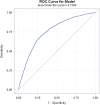The Interaction Effects of Meteorological Factors and Air Pollution on the Development of Acute Coronary Syndrome
- PMID: 28276507
- PMCID: PMC5343658
- DOI: 10.1038/srep44004
The Interaction Effects of Meteorological Factors and Air Pollution on the Development of Acute Coronary Syndrome
Abstract
This study investigated the interaction effects of meteorological factors and air pollutants on the onset of acute coronary syndrome (ACS). Data of ACS patients were obtained from the Taiwan ACS Full Spectrum Registry and comprised 3164 patients with a definite onset date during the period October 2008 and January 2010 at 39 hospitals. Meteorological conditions and air pollutant concentrations at the 39 locations during the 488-day period were obtained. Time-lag Poisson and logistic regression were used to explore their association with ACS incidence. One-day lag atmospheric pressure (AP), humidity, particulate matter (PM2.5, and PM10), and carbon monoxide (CO) all had significant interaction effects with temperature on ACS occurrence. Days on which high temperatures (>26 °C) and low AP (<1009 hPa) occurred the previous day were associated with a greater likelihood of increased incidence of developing ACS. Typhoon Morakot was an example of high temperature with extremely low AP associated with higher ACS incidence than the daily average. Combinations of high concentrations of PM or CO with low temperatures (<21 °C) and high humidity levels with low temperatures were also associated with increased incidence of ACS. Atmospheric pollution and weather factors have synergistic effects on the incidence of ACS.
Conflict of interest statement
The authors declare no competing financial interests.
Figures



References
-
- Lopez A. D., Mathers C. D., Ezzati M., Jamison D. T. & Murray C. J. Global and regional burden of disease and risk factors, 2001: systematic analysis of population health data. The Lancet 367, 1747–1757 (2006). - PubMed
-
- White H. D. & Chew D. P. Acute myocardial infarction. The Lancet 372, 570–584 (2008). - PubMed
-
- Taiwan Department of Health. Statistics data. Statistical analysis of 2009 mortality data. Press conference on 2009 mortality data. Available: http://www.doh.gov.tw. Accessed 2011 Jan 19.
Publication types
MeSH terms
LinkOut - more resources
Full Text Sources
Other Literature Sources
Medical

